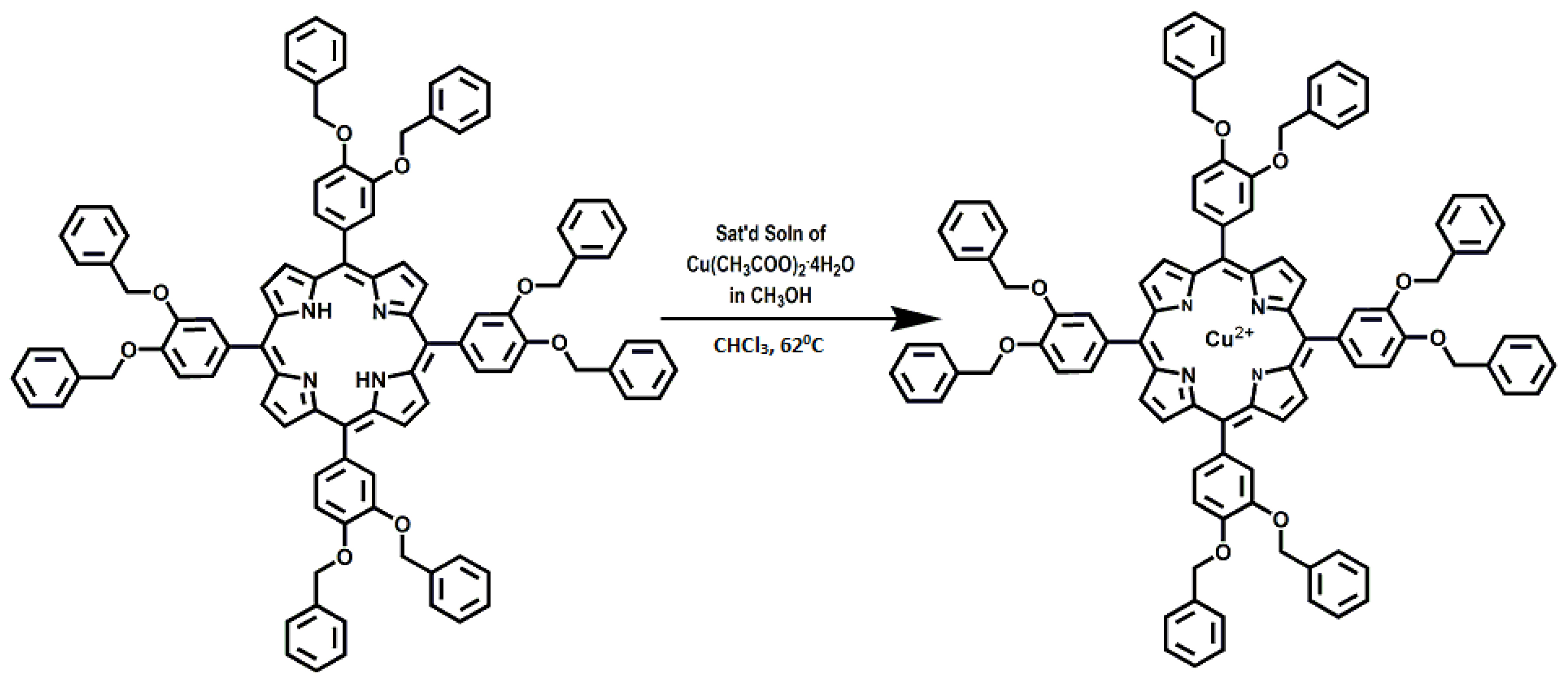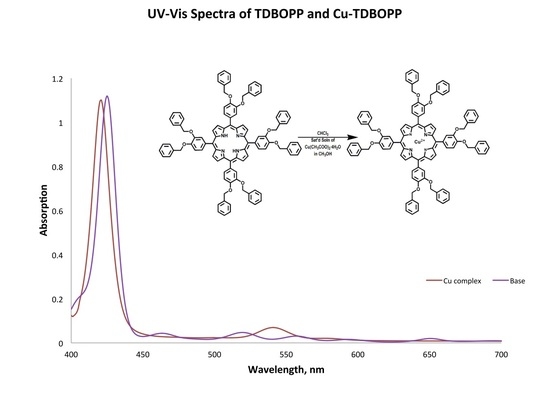Copper 5,10,15,20-Tetrakis-(3,4-dibenzyloxyphenyl)porphyrin
Abstract
:1. Introduction
2. Results
2.1. Copper 5,10,15,20-Tetrakis-(3,4-dibenzyloxyphenyl)porphyrin
2.2. Construction of Gratzel Cell
3. Discussion
4. Materials and Methods
4.1. Chemicals and Reagents
4.2. Instrumentation
5. Conclusions
Supplementary Materials
Acknowledgments
Author Contributions
Conflicts of Interest
References
- Dolphin, D. The Porphyrins; Academic Press: New York, NY, USA, 1978. [Google Scholar]
- Kobayashi, K.; Masuda, T. Tetrapyrrole Biosynthesis in Plant Systems. In Handbook of Porphyrin Science; Kadish, K., Smith, K., Guilard, R., Eds.; World Scientific Publishing Co. Pte. Ltd.: Singapore, 2012; pp. 141–211. [Google Scholar]
- Drain, C.M.; Singh, S. Combinatorial Libraries of Porphyrins: Chemistry and Applications. In Handbook of Porphyrin Science; Kadish, K., Smith, K., Guilard, R., Eds.; World Scientific Publishing Co. Pte. Ltd.: Singapore, 2010; pp. 485–537. [Google Scholar]
- Milgrom, L.R. The Colours of Life: An Introduction to the Chemistry of Porphyrins and Related Compounds; Oxford University Press Inc.: New York, NY, USA, 1997. [Google Scholar]
- Hasobe, T. Supramolecular Assemblies of Porphyrin and Phthalocyanine Derivatives for Solar Energy Conversion and Molecular Electronics. In Handbook of Porphyrin Science; Kadish, K., Smith, K., Guilard, R., Eds.; World Scientific Publishing Co. Pte. Ltd.: Singapore, 2014; pp. 148–194. [Google Scholar]
- Tebo, A.; Herrero, C.; Aukauloo, A. Porphyrins and Metalloporphrins as Components in Artificial Photosythesis Research. In Handbook of Porphyrin Science; Kadish, K., Smith, K., Guilard, R., Eds.; World Scientific Publishing Co. Pte. Ltd.: Singapore, 2014; pp. 196–233. [Google Scholar]
- Li, L.-L.; Diau, E.W.-G. Porphyrin-sensitized solar cells. Chem. Soc. Rev. 2013, 42, 291–304. [Google Scholar] [CrossRef] [PubMed]
- Campbell, W.M.; Jolley, K.W.; Wagner, P.; Wagner, K.; Walsh, P.J.; Gordon, K.C.; Schmidt-Mende, L.; Nazeeruddin, M.K.; Wang, Q.; Gratzel, M.; et al. Highly efficient porphyrin sensitizers for dye-sensitized solar cells. J. Phys. Chem. C 2007, 111, 11760–11762. [Google Scholar] [CrossRef]
- Mathew, S.; Yella, A.; Gao, P.; Humphry-Baker, R.; Curchod, B.F.E.; Ashari-Astani, N.; Tavernelli, I.; Rothlisberger, U.; Nazeeruddin, M.K.; Grätzel, M. Dye-sensitized solar cells with 13% efficiency achieved through the molecular engineering of porphyrin sensitizers. Nat. Chem. 2014, 6, 242–247. [Google Scholar] [CrossRef] [PubMed] [Green Version]
- Tidwell, C.P. Synthesis and Characterization of 5,10,15,20-Tetrakis-(3,4-dibenzyloxyphenyl)porphyrin. 2016; Submitted for publication. [Google Scholar]
- Ito, S.; Nazeeruddin, M.K.; Liska, P.; Comte, P.; Charvet, R.; Péchy, P.; Jirousek, M.; Kay, A.; Zakeeruddin, S.M.; Grätzel, M. Photovoltaic characterization of dye-sensitized solar cells: Effect of device masking on conversion efficiency. Prog. Photovoltaics Res. Appl. 2006, 14, 589–601. [Google Scholar] [CrossRef]
- Hagfeldt, A.; Boschloo, G.; Sun, L.; Kloo, L.; Pettersson, H. Dye-sensitized solar cells. Chem. Rev. 2010, 110, 6595–6663. [Google Scholar] [CrossRef] [PubMed]
- Mironov, A. Transition Metal Complexes of Porphyrins and Porphyrinoids. In Handbook of Porphyrin Science; Kadish, K., Smith, K., Guilard, R., Eds.; World Scientific Publishing Co. Pte. Ltd.: Singapore, 2012; pp. 304–414. [Google Scholar]

© 2017 by the authors; licensee MDPI, Basel, Switzerland. This article is an open access article distributed under the terms and conditions of the Creative Commons Attribution (CC BY) license (http://creativecommons.org/licenses/by/4.0/).
Share and Cite
Mathews, L.D.; Tidwell, C.P.; Bharara, P.; Stephens, G.; Su, T.Y.; Carter, A. Copper 5,10,15,20-Tetrakis-(3,4-dibenzyloxyphenyl)porphyrin. Molbank 2017, 2017, M931. https://doi.org/10.3390/M931
Mathews LD, Tidwell CP, Bharara P, Stephens G, Su TY, Carter A. Copper 5,10,15,20-Tetrakis-(3,4-dibenzyloxyphenyl)porphyrin. Molbank. 2017; 2017(1):M931. https://doi.org/10.3390/M931
Chicago/Turabian StyleMathews, L. Dalila, Cynthia P. Tidwell, Prakash Bharara, Glenn Stephens, Ting Yu Su, and Alexia Carter. 2017. "Copper 5,10,15,20-Tetrakis-(3,4-dibenzyloxyphenyl)porphyrin" Molbank 2017, no. 1: M931. https://doi.org/10.3390/M931





